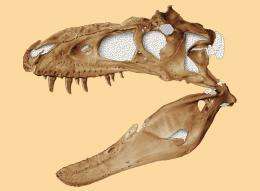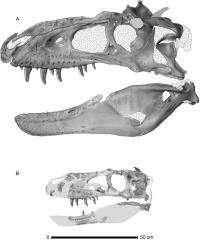Scientists Discover New Species of Tyrannosaur

New Mexico is known for amazing local cuisine, Aztec ruins and the Los Alamos National Laboratory. In the January issue of the Journal of Vertebrate Paleontology, paleontologists Thomas Williamson of the New Mexico Museum of Natural History and Thomas Carr of Carthage College bring a new superstar to the state.
Bistahieversor sealeyi (pronounced: bistah-he-ee-versor see-lee-eye) is a brand new species of tyrannosaur discovered in the Bisti/De-na-zin Wilderness of New Mexico.
Tyrannosaurs include the famous meat-eating dinosaur movie-stars like T. rex, and their characteristic body and skull shape (not to mention that mouthful of ferocious teeth!) make them easy for paleontologists and kids to recognize.
The skull and skeleton of Bistahieversor were collected in the first paleontological excavation from a federal wilderness area, and the specimen was airlifted from the badlands by a helicopter operated by the Air Wing of the New Mexico Army National Guard.
“Bistahieversor sealeyi is the first valid new genus and species of tyrannosaur to be named from western North America in over 30 years,” says Williamson.

Tyrannosaurs are best known from 65-75 million year old sediments from the Rocky Mountain region of North America. Bistahieversor provides important insights into the evolutionary history of the group.
“Bistahieversor is important because it demonstrates that the deep snout and powerful jaws of advanced tyrannosaurs like T. rex were special adaptations that evolved around 110 million years ago, after the eastern and western halves of North America were separated by a shallow sea,” says Carr. Bistahieversor was different from other tyrannosauroids in having an extra opening above its eye, a complex joint at its “forehead,” and a keel along its lower jaw; it also had more teeth than its distant relative T. rex.
Bistahieversor skulls and skeletons collected from the Bisti/De-na-zin Wilderness and from the lands of the Navajo Nation are currently on display at the New Mexico Museum of Natural History.
Provided by Society of Vertebrate Paleontology





















